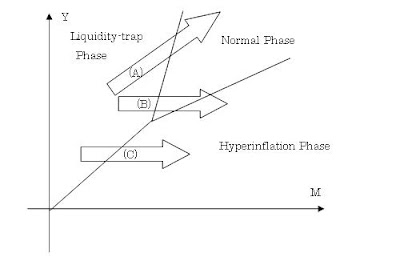G ≡ U - τσ + pV
where U is the internal energy, τ is the temperature, σ is the entropy, p is pressure, V is volume.
Therefore,
dG = dU - τdσ - σdτ + pdV + Vdp
Now: "Consider a system in thermal contact with a heat reservoir R1 at temperature τ and in mechanical contact with a pressure reservoir R2 that maintains the pressure p, but cannot exchange heat." (Kittel p.262)
In this system S, dτ=0 and dp=0, so
dGS = dUS - τdσS + pdVS
In equilibrium, this equals zero for each set of (τ,p).
In monetary economics, excess demand for money can be derived from equation of exchange as follows:
G ≡ PY - MV
where P is the price, Y is the output, M is the money, V is the velocity of money.
Therefore,
dG = dPY + PdY - dMV - MdV
Now, consider a mediating system in financial contact with a central bank R1 that maintains the money M and in transactional contact with a real economy R2 that maintains the output Y.
In this system S, dM=0 and dY=0, so
dGS = YdPS - MdVS
In equilibrium, this equals zero for each set of (M,Y).

This analogy is the idea behind the previous post.
From this analogy, you can derive the monetary economics version of Clausius-Clapeyron relation. Note that in this analogy p(pressure) corresponds to Y(output), V(volume) corresponds to P(price), τ(temperature) corresponds to M(money), and σ(entropy) corresponds to V(velocity of money).
